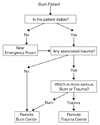The Primary Care for Burns
Article information
Abstract
Recently burn care system in Korea has been changing from 'general care' to 'specialized care'. Consequently, most physicians and surgeons who do not work in burn centers could rarely have an opportunity to gain experience in burn care. Before being transferred to a burn center, every burn patient is usually treated primarily by the non-experts. Therefore, all primary physicians need to know the primary care for burns. The main components of the primary care are pre-hospital care, emergency room (ER) care, and decision-making process for the transfer of the patients to a burn center. Pre-hospital care and ER care are on the same spectrum, and composed of the advanced trauma life support (ATLS) primary survey, wound cooling, pain control, fluid therapy, high concentration oxygen therapy, cyanide antidote therapy, and burn wound care including escharotomy. Rapid and proper management for smoke inhalation is essential for acute stage survival of burn patients. Once the patient is stabilized, a decision regarding his/her disposition to a burn center is critical. Inappropriate transfer of minor burn patients to burn centers imposes unnecessary cost and discomfort to the patients. The primary care for burns is very important and medical personnel who are in charge of burn patients should be familiar with it.


